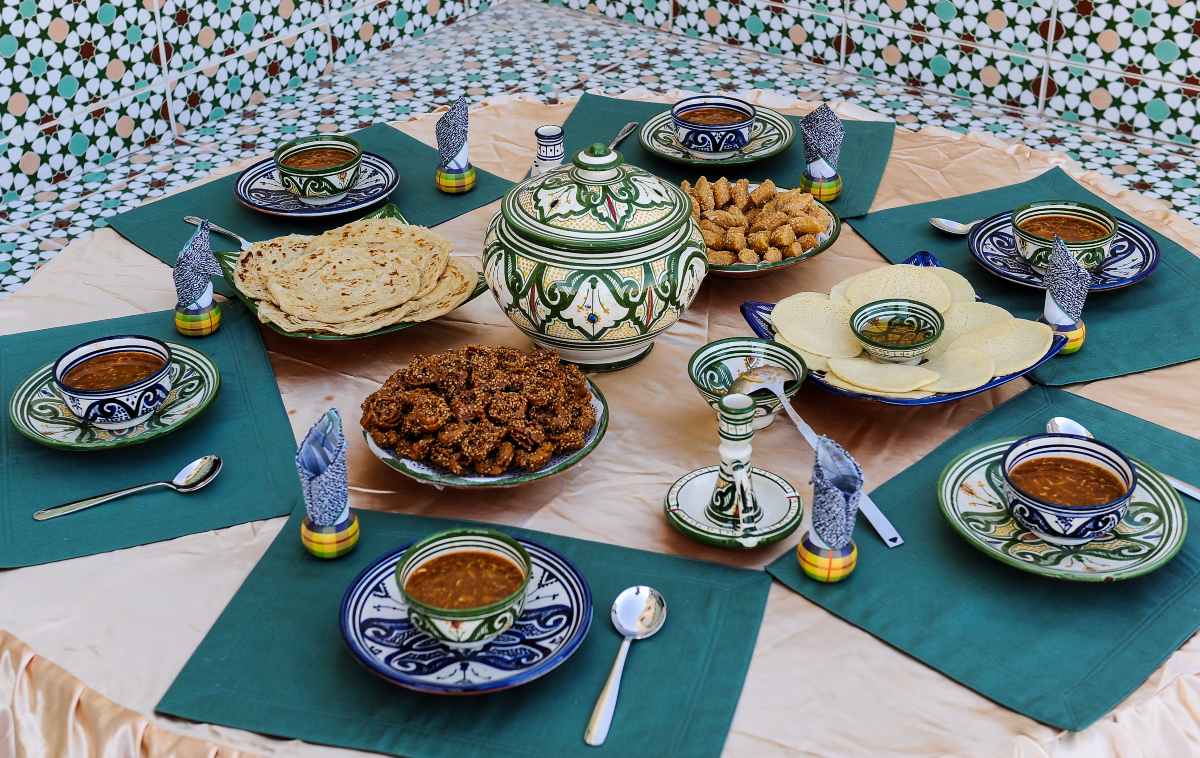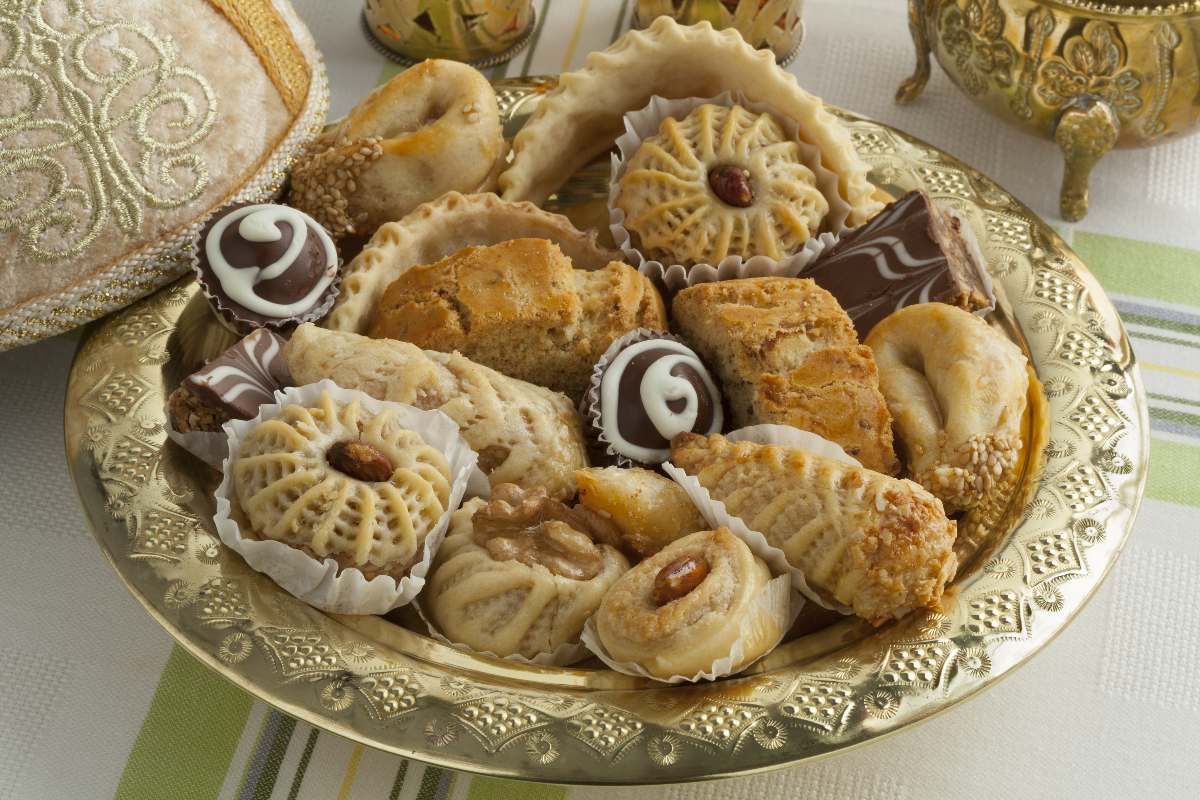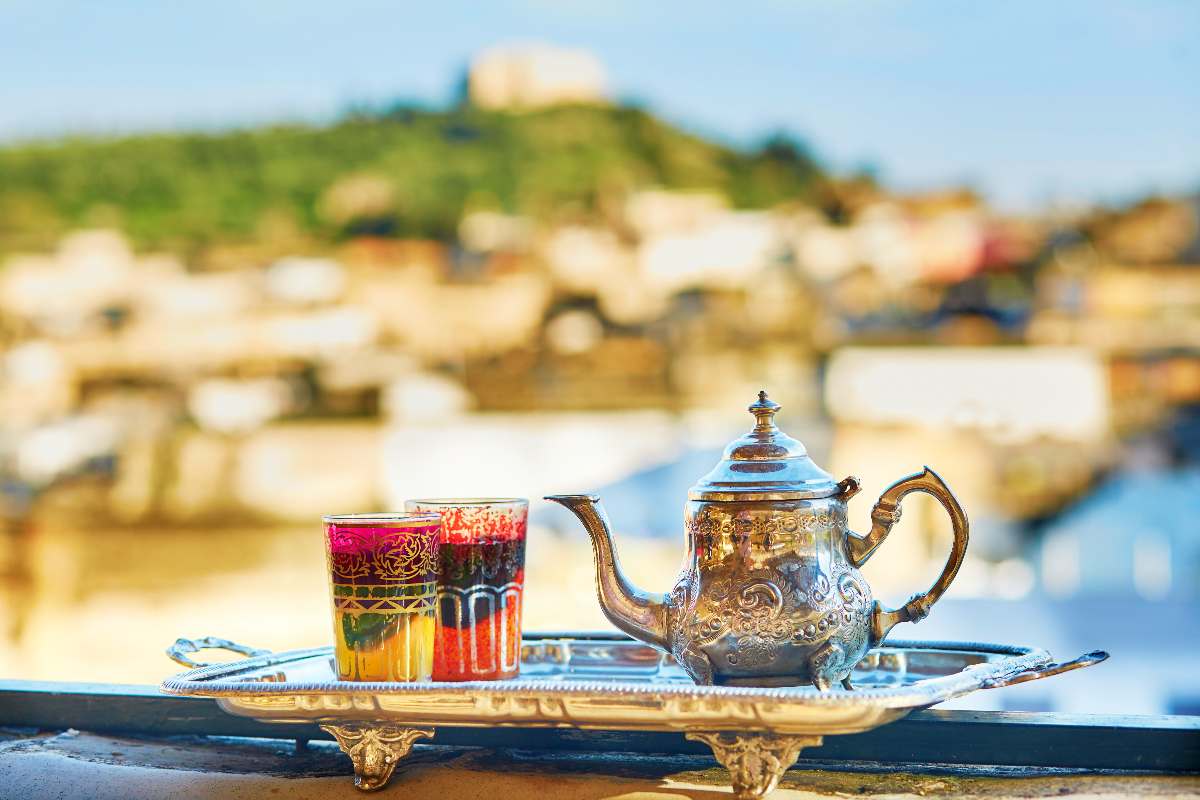If you like to try the local cuisine during your travels abroad, in Morocco you will have a great time: Moroccan cuisine has a lot of personality and really tasty dishes, for all tastes and, moreover, at very affordable prices. In this page we give you information about Moroccan gastronomy: its origins, its characteristics, its main dishes and the way in which the citizens of the country live it day by day.
Morocco’s gastronomy is, like so many other cultural expressions of the country, a good reflection of its traditions and history. Undoubtedly, the one that has more weight is the Arab, which is why there are many points in common with the cuisines of the Maghreb and all of North Africa and the Middle East in general.
But it is also possible to find elements in common with Berber cuisine, which has maintained genuine dishes, ingredients and techniques in the places where this population has an important presence, for example south of the Atlas. In addition, the most educated palates will be able to find details that denote contact with other cultures, such as Hebrew, Andalusian or Andalusian or French.
On the other hand, another characteristic element can be highlighted, but this time by absence: in the gastronomy of Morocco you will hardly find details reminiscent of Turkish cuisine, as is the case in the rest of North Africa: this is because the Ottoman Empire never came to dominate this territory, even when it was at its peak. Some historians tend to indicate the 14th century and the Merinid dynasty as the period in which Moroccan cuisine began to define its own personality, developing since then ‘over a slow fire’, never better said.
In addition, Morocco’s gastronomy is in turn strongly conditioned by its geographical and climatic characteristics. Although it is estimated that less than 20% of the country’s territory is arable, the primary sector accounts for a significant percentage of GDP (around 14%) and agricultural activity employs approximately 40% of the population, especially in rural areas. All this indicates a low productivity rate but, in the eyes of foreign tourists, it represents a good opportunity to come into contact with local gastronomy, on a small scale, as in the past.

Before going into the details of the typical dishes, it is worthwhile to review the main characteristics that define Moroccan gastronomy, especially its products and raw materials.
As we said, the low productivity of Morocco’s agricultural sector means that large farms are not the predominant feature: the raw material for Moroccan cuisine continues to be produced, to a large extent, on a small scale by farmers and livestock breeders who continue to use traditional techniques. This is what is often referred to as local or kilometer 0 production… which has been done in Morocco all its life and, in fact, has never ceased to be done.
Moreover, it is still a very seasonal gastronomy: while in Western markets you can find all kinds of products at any time of the year (reflecting a globalized economy and greenhouse agriculture), in Morocco, the time of the year still has a great influence, especially if you go to the popular markets. In this sense, in autumn you will find more figs, pomegranates and grapes; in spring more apricots, cherries, strawberries and peaches; in summer more watermelons and tomatoes; and in winter more oranges, tangerines, carrots, root vegetables, beets and onions, among other examples.
This, by the way, is a demonstration that fruits and vegetables are very important in Moroccan gastronomy, not only served raw and cold, but also in hot preparations, for example in the oven or in stews.
In Morocco, people eat a lot of meat, but not just any meat: it must be halal. In order to be certified, the animal from which the meat is extracted must have met a series of requirements in accordance with Sharia or Islamic law. In particular, it must have been sacrificed in the name of Allah and following very specific incision and cutting techniques. In addition, pork, which is considered an impure animal, is prohibited, as is the consumption of clawed fowl.
Thus, the most common meat is lamb and poultry, although there are others such as kid, veal or beef that are also used in very popular dishes. The use or consumption of animal blood is also not permitted, nor is the use of non-halal additives. Neither alcohol nor toxic ingredients should be used in the preparation of meat products.
It must be said that in recent times, halal meat is becoming very fashionable among non-Muslims as well, for different reasons. For example, because the ingredients used in these meat products are natural and homemade, precisely because of the requirements of halal certification. In addition, most of the meat consumed in Morocco comes from extensive livestock farms (in open fields), unlike the meat consumed in the West, which is intensive (in factories). And it is well known that extensive livestock farming implies greater respect for the environment.
In this sense, it should be said that the people of Morocco, since time immemorial, have been highly appreciated shepherds and breeders on the other side of the Strait of Gibraltar, where they could have exported their knowledge, their techniques and even their own flocks, giving rise to the prized Merino sheep in Spain.
Fish is not as abundant as meat or vegetables, but you will find it to a greater extent in coastal areas. Some cities have important fishing ports, where a thriving industry and export activity to other countries has developed. This is the case in Casablanca, Agadir and Tangier, three of the main cities for this sector.
But for the tourist, perhaps the most beautiful thing is that the fishing activity continues to bring the delicacies of the sea in the fish markets and restaurants located on the beachfront, especially in some really picturesque enclaves. This is the case of Essaouira, El Jadida, Asilah, Taghazout or Moulay Bousselham, where eating on a terrace by the port is a very special pleasure.
Among the main species caught are sardines, tuna, horse mackerel and mackerel, which are often canned. But sea bream, hake, sole or sea bass are also common, with a very fresh character and caught close to the coast. Seafood, for its part, also occupies a prominent place in many ports: oysters, sea urchins, crabs and a long etcetera. The easiest way to prepare it is grilled, but it can also be pickled or even cooked and then served in a tajine.
One of the main characteristics of Moroccan gastronomy is its spicy character: there are few dishes that do not contain some type of spice or aromatic herb, and the same is true of the marinades for meat products, which thus acquire a very powerful taste and aroma.
Among the most common spices in Morocco are cinnamon, ginger, saffron, nutmeg, turmeric and cumin. But perhaps most striking for a foreign visitor is the omnipresence of the ras el hanouta mixture of spices whose recipe is really secret, as no producer or cook wishes to reveal what theirs is made of. It is assumed that it contains the spices mentioned above, as well as black pepper, paprika or cardamom, but it is not known if it contains more or in what quantity. Some ras el hanout can contain up to 30 different spices!
In addition, there are some very popular sauces that are composed of these spices and other ingredients that give them their liquid or pasty consistency. This is the case of
mhammar
(based on paprika, cumin and butter), the
mqalli
(saffron, oil and ginger) or the
smen
also known as Moroccan butter (butter with chickpea or almond paste and vegetable stock).

In Moroccan gastronomy there is a strong presence of sweets, with a great variety of regional proposals but also really national elaborations. One of the most interesting aspects is that they tend to have a social character, whether festive or hospitality. For example, sweets are very common in the
iftar
or the time at which the fast of the day during Ramadan ends.
Precisely for this reason, far from being ‘delicatessen’ type sweets, they are very consistent elaborations that give energy and fill the stomach, forming part of the day’s diet, not as a simple whim. In this regard, it is worth highlighting the
chebakia
(flour, egg, butter, toasted almonds, sesame and honey) or the
sfenzh
(a fried doughnut, covered with honey or sugar).

The variety of beverages in Morocco is also very large, and almost all have in common their absence of alcohol, as Islam prohibits its consumption. In the first place of popularity and visibility is tea, specifically Moorish tea (green tea with mint). It is offered to guests at home, to customers in stores (in the context of a bargaining and selling process) and even in the desert. In fact, it is a very important drink in the Berber culture, which probably assimilated it as a method to combat dehydration due to the high temperatures in the desert.
Fruit juices also deserve special mention, especially orange juice, since the production of this citrus fruit is very important in Moroccan fields. And we can’t forget the milk-based drinks either, with a surprising variety, such as sour milk (with honey and thyme).
On the other hand, wine production is anecdotal and residual, with a few vineyards in the Meknes area and a focus on export, given the prohibition of its consumption among Muslims. On the other hand, there are some traditional liqueurs (figs), which are rooted in the Sephardic culture and, therefore, related to the Moroccan Jews.
Moroccan cuisine uses a wide variety of techniques to prepare its dishes. And for these techniques to be effective, he uses tools that are sometimes only found in this country or in other surrounding countries.
The steaming process for cooking the couscous is unique and requires the use of a couscous pot, a kind of two-tier casserole dish: the lower one for the water or broth, and the upper one (with small perforations) for the couscous grains.
No less striking are the truncated cone-shaped clay chimneys used to serve the tajines. In fact, with these utensils not only the heat is preserved, but also the humidity of the ingredients, as it condenses and runs down the inside walls to return to the dish or casserole, generally also made of clay.
Moroccan gastronomy often uses stews in casseroles, some of them with slow cooking, a nod to the Sephardic dishes called adafinas. Frying is another very common resource, in some cases with local oil: argan oil. And grilling is also a very common option, sometimes in the form of a rotating skewer, especially for meats.
There is no lack of grilled or baked dishes, while in other cases the ingredients are served raw, such as vegetables. In this case, it is advisable to take extreme precautions and make sure that the washing water was adequate to avoid intoxication. And in the desert, a type of roasting on embers buried under the ground is still used, which is a very traditional resource among the nomadic population.
Moroccans usually distribute their eating habits in three main moments: breakfast, lunch and dinner. But snacks are also available for snacking between meals. Moreover, the distribution of portions among these three main moments differs greatly depending on the time of the year and the time available for eating.
During your trip, your lunches are likely to include orange juice, coffee and French pastries, but also local delicacies such as fluffy pancakes, Moroccan bread (khobz), local sweets (rghaif) and the characteristics sfenzh or fried doughnuts, which can sometimes be topped with a fried egg, if a particularly hearty breakfast is desired.
Lunch can take several hours after noon, especially in the peak heat season, when life on the street slows down and the body asks for a little rest in the shade indoors. If you are short on time, it may be a good time to sample one of the many tajines, but if you are not in a hurry, you can also choose a three-course lunch, making this the main meal of the day.
None of this applies if you are traveling during Ramadan, when obligatory fasting is performed during the day. Outside this period, dinner is usually relatively frugal (e.g., with some soup, a vegetable dish or leftovers from lunch for families who dine at home), but during the fasting month, dinner (
iftar
) becomes a real feast, often with other relatives or friends, being the time of the most consistent dishes and sweets.
And when the house is really thrown down is at large family banquets, such as a wedding, a family bonding gathering or a baby shower. The variety of dishes and the generosity of the portions is particularly high, as well as the number of attendees.
And now that you know the keys to Moroccan cuisine, the most important thing is to know which are the typical dishes that you can find in the country and that, for sure, will be part of your diet during your trip, at least if you conceive gastronomy as a full-fledged cultural experience:
As you can see, the richness of Morocco’s gastronomy is outstanding. So if you want to turn your trip to the country into a cultural and tasty experience, let us know and we will choose the best restaurants and hotels from the point of view of traditional cuisine.
Fill out the form below to receive a free, no-obligation, tailor-made quote from an agency specialized in Morocco.
Travel agency and DMC specialized in private and tailor-made trips to Morocco.
Mandala Tours, S.L, NIF: B51037471
License: C.I.AN-187782-3